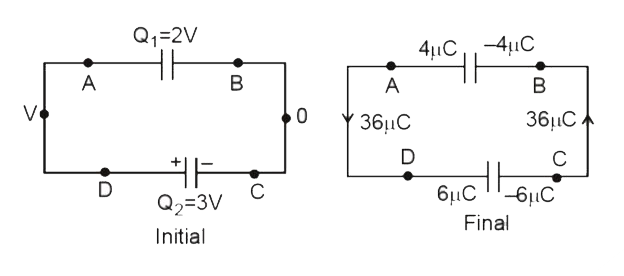Repeat above Question 3, if the charge is negative and the angle made by the boundary with the velocity is θ=π6.
2π−2θ=2π−2×π6=2π−π3=5π3=ωt=qBmt
⇒t=5πm3qB
(b) Distance travelled s=r(2π−2θ)=5πr3

(c) Impulse =charge in linear momentum
=m(−vsinθˆi+vcosθˆj)
−m(vsinθˆi+vcosθˆj)
=−2mvsinθˆi=−2mvsinπ6ˆi=−mvˆj
Topper's Solved these Questions
- MAGNETIC FIELD AND MAGNETIC FORCESBOOK - CENGAGE PHYSICSCHAPTER - MAGNETIC FIELD AND MAGNETIC FORCESEXERCISE - Exercise 1.2
13 Videos
- MAGNETIC FIELD AND MAGNETIC FORCESBOOK - CENGAGE PHYSICSCHAPTER - MAGNETIC FIELD AND MAGNETIC FORCESEXERCISE - Exercise1.3
14 Videos
- MAGNETIC FIELD AND MAGNETIC FORCESBOOK - CENGAGE PHYSICSCHAPTER - MAGNETIC FIELD AND MAGNETIC FORCESEXERCISE - Solved Example
25 Videos
- KINETIC THEORYBOOK - CENGAGE PHYSICSCHAPTER - KINETIC THEORYEXERCISE - Question Bank
31 Videos
- Magnetism and MatterBOOK - CENGAGE PHYSICSCHAPTER - Magnetism and MatterEXERCISE - Question Bank
50 Videos
Similar Questions
Knowledge Check
In above question, the charge flown is :
A2QBQC3QD3Q2In the above question, the velocity
Aincreases between points O and ABincreases between points A and BCdecreases between points A and BDis zero throughoutIn the above question, the angular velocity will:
AincreaseBdecreaseCnot changeDnothing can be said
What is the change in velocity in the above question?
View SolutionA line makes angles of measures π6 and π3 with X-and Z-axes respectively. Find the angle made by the line with the Y-axis.
View SolutionIf ˆaandˆb are two unit vectors and θ is the angle between them then vector 2ˆb+ˆa is a unit vector if (A) θ=π3 (B) θ=π6 (C) θ=π2 (D) θ=π
View SolutionIn the previous problem, the maximum range of movement of the centre of the part of the circle from line AD in which charged particle of charge Q moves with a velocity v when (θ) is positive to when (θ) is negative is given by
View SolutionA mirror is inclined at an angle of θ with the horizontal. If a ray light is incident at an angle θ as shown , then the angle made by reflected ray with the horizontal is
_E01_002_Q01.png)
View Solution

